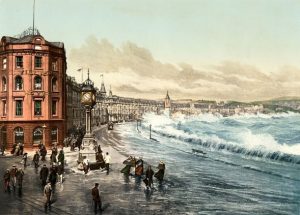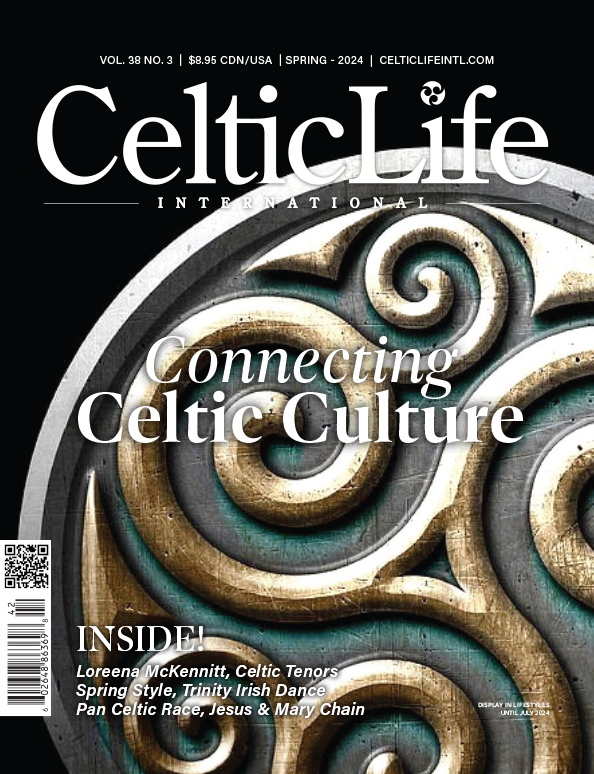
It is estimated that the Isle of Man has been around since about 8000 BC. Rising water levels cut the island off from surrounding islands and it has stood alone since approximately that time. Archaeological evidence suggests that the colonization of the island by sea took place sometime before 6500 BC.
The first residents lived in small huts and were hunters, fishers and gatherers of their food. They used small tools made of flint or bone and archaeological examples of these have been found on the island near the coast. Today, the Manx Museum on the Isle of Man houses these relics.
The Neolithic period brought the knowledge of farming, better stone tools, and pottery making. Also during this period the megalithic monuments began to appear around the island. They were used as communal tombs.
For example, King Orry’s grave at Laxey was found at Cashtalyn Ard near Maughold, and the Meayll Circle of stones is near Cregneash on the island.
The Bronze age brought smaller burial grounds to replace the communal tombs of the megalithic builders.
With the Iron Age came the Celts who inhabited the island and brought their cultural influence. There is archaeological evidence of hill forts that appear on hills, summits and smaller forts along the coastal cliffs. There is evidence of framed round houses of the Celts.
It is believed the first Celts to inhabit the island likely were the Britons from mainland Britain and they brought their Brittonic language with them. This was the first Celtic language on the island.
Interestingly, the Romans never conquered the island, so there is no Roman influence here as there are with other Celtic nations. The secular history of the Isle of Man during this Celtic period remains a mystery and it is speculated that the island may have become a haven for the Druids and other refugees from Anglesey (in Britain) after the Sacking of Mona in 60 AD.
Edwin of Northumbria in 616 did conquer the Isle of Man and Anglesey, but this did not last long. During this century came the cultural influence from Ireland and the migration brought a process of Gaelecization as evidenced by the Ogham stone inscriptions found on the island. This evidence is proof of Primitive Irish influence on the island.

It is the Primitive Irish, followed by the Middle and Modern Irish, which is a Goidelic language long with Scottish Gaelic, that took over the Brittonic languages and that gave rise to the Manx language. It is generally believed by scholars that the Irish invasions or migrations formed the basis for the modern Manx language. It is believed the first dialects the islanders spoke were identical to the Gaelic of Ireland.
Land divisions and place names attest to this and today of the 1500 place names on the island about 68% are Celtic. The same is with the surnames on the island; of 170 names about 65% are Celtic names.
Ecfrid’s Northumbrians who in 684, laid waste in Ireland from Dublin to Drogheda, also temporarily occupied Man, but they also caused the migration from Ireland to the Isle of Man in the first place.
Also, around this time, St. Maughold (Maccui in Manx), an Irish missionary converted the island to Christianity and gives his name to a parish on the island. And, a number of Columban monks (followers of St. Columba) resided on the Isle of Man until about the end of the 6th century, so the island was converted to Christianity early on.
The Celtic era of the Isle of Man lasted from the Iron Age to the Scandinavian Period which began around the 9th century.
After the brief conquests of the Northumbrians and the migration of the Irish to the island, came the period of Scandinavian rule and dominance on the island. And, of course, with that came the Norse influence in the culture and Manx language.
There are two main eras on the Isle of Man that can be broken down to: before the conquest of Godred Crovan, a Norse king, in which there was unsettled rule and warfare on the island after Crovan’s conquest in which there was relative peace on the island
At first, the Vikings came to plunder the island and did not stay long. Then, from 850 to 990 AD the Vikings returned and settled in to live on the island. Now the island fell under the rule of the Scandinavian Kings of Dublin and from 900 to 1079 the island came under the dominance of the powerful Earls of Orkney.
This is evidenced by the mint produced coins on the Isle of Man between c.1025 – c.1065. They were minted from an imported type 2 Hiberno-Norse penny die from Dublin. These coins were first minted under Sihtric, the King of Dublin.
Godred Crovan, Norse king, invaded the Isle of Man around 1079 AD and created the Kingdom of Man and the Isles. His successors continued to take this title. His kingdom included the southwest islands of Scotland (Sodor) until around 1164 AD when two separate kingdoms were formed. Also originally under this rule were the Hebrides islands and other small islands of Scotland.
During the 1130’s, the Catholic Church sent a small mission to establish the first bishopric on the Isle of Man, Wimund, who became the first bishop. By 1154 The Diocese of Sodor and Man was formed under the Church of England.
From approximately 1113 to 1152, Crovan’s son Olaf ruled and maintained considerable power and a close alliance with the kings of Ireland and Scotland. During this period, no one disturbed the island which relatively had a time of peace.

Olaf’s son, Godred (reigned 1153-1158) but lost the smaller islands off the coast of Argyll. During this Scandinavian period, the rule of the Isle of Man remained under the overall rule of the Kings of Norway.
Then, from the mid-12th century to 1217 the Isle of Man came under the control and power of the kingdom of Scotland. This period of Scots control would preceded the establishment of full English control. Hence, the Scottish Gaelic language had some influence over the Manx language.
During the 13th century, Scot Ragnald (reigned 1187-1229) paid homage to King John of England (reign; 1199-1216) and during this time the English intervened in the affairs of the Isle of Man, much to the consternation of the Scots.
Alexander III of Scotland, in 1261, sent envoys to Norway to negotiate the cession of the Isle of Man to Scotland but the Norwegian king resisted. This caused hostilities to begin and Alexander defeated the Norse. Magnus Olafsson, King of Man and Isles (reigned 1252-1265) was forced surrender all the islands to Scotland.
So even with the Norse language and influence the Celtic element remained in the Manx Gaelic language and is attested to on the stone crosses from the 12th century AD. Of these crosses, 42% of the names are Celtic and not Scandinavian.
It was the Treaty of Perth (1266) in which King Magnus VI of Norway formally ceded the islands including the Isle of Man to Scotland.
Then, in 1290, King Edward I of England sent Walter de Huntercomb to take possession of the Isle of Man and it remained in English hands until 1313 with English being spoken on the island now as well as Manx.
Scot, Robert the Bruce took over the island after besieging Castle Rushen for five weeks. From then until about 1346 was a period of confusion as the Isle of Man went back and forth under Scottish and English rule.
Finally, Sir John Stanley in 1406 became the English governor of the Isle of Man and now it became a more settled era in the Isle of Man’s history under English rule. The English language accompanied Sir Stanley to the island and English also had an influence on the Manx language.
In 1765, the lordship was revested into the British Crown but the island never became part of the Kingdom of Great Britain or its successor the UK. The Isle of Man has retained its status as an internally self-governing Crown dependency through to today.






















Leave a Comment